Looking back on Mike Racke’s ground-breaking 1970 Chevelle SS, packing a twin-turbocharged 6.6-litre Duramax diesel V8
This article on Bob’s Chevelle was originally published in the June 2009 issue of Street Machine
IN THIS game, the Street Machine staffers have seen it all. Or so we thought until we saw Mike Racke’s ground-breaking Chevelle.
“I wanted to build something unique,” says the Californian motorhead. “I built a ’70 Chevelle 10 years ago with a Bill Mitchell 509. Back then it was different but now there are so many cars like it, it just blends in. This time I wanted to build something that has never been done before.”
Picking a Chevelle was easy — Mike manages Muscle Factory in the US, which specialises in parts for ’64–’72 Chevelles and El Caminos.
But how do you do something different with one of America’s most popular muscle cars? Well, Mike went totally off the reservation and fitted a twin-turbocharged 6.6-litre Duramax diesel V8 to his new ride.
You’d think most people would ask why but high-performance diesel power is big in the US. We just don’t see much of it down here in Oz.
He visited Joe Komaromi at Pacific Performance Engineering, which specialises in performance diesels, and was convinced on the spot.
“He showed me an 8000lb (3629kg) H1 Hummer with a Duramax,” he says. “I went for a ride in this thing and was amazed. It was like riding in my 10-second Chevelle — but in an 8000lb Hummer! If it can make a Hummer move like that, what would it do in a 4000lb car? Once you feel the power a diesel makes you’ll never want to build a gas motor again.”
The guys at PPE are getting 650rwhp out of diesel pick-ups with just bolt-on parts — that’s impressive.
Let’s run some numbers by you. Mike reckons his beast will punch out about 900hp as it is, and as much as 1200hp and 2000ft-lb of torque when the nitrous he’s recently fitted is switched on! Yet it gets 32mpg on the road. So it’s faster than a V8 Supercar but no thirstier than a modern econobox. All of a sudden, fitting an engine that runs on tractor fuel makes a lot more sense.
“It’s got about 400 miles on it, just cruising around town. It’s fun to drive! We’ve jumped on it a couple of times but you have to get off right away because there’s no room. It definitely gets going in a hurry. We’ve got a 10-second Chevelle here and it’s way quicker than that.”
He bought the Chevelle from a friend. “It was in pretty bad shape but the price was right and I knew I was going to throw away most of the car.”
He’s not joking, either — there’s hardly anything of the original left.
Two turbos and 6.6 litres of diesel grunt. Since the photos, Mike’s added a two-stage nitrous kit, which will produce around 1200hp when the boost is cranked to 30psi. At which point it’ll have enough torque to tow an ocean liner
Initially, Mike fitted the Duramax donk between the stock frame rails but he wasn’t happy with how it looked. For a street car he reckons it would’ve been fine but he had plans to throw big power into the car and give it some curry down the strip. The stock chassis wasn’t going to stand up to that.
So he chopped out the whole floor from front to back and bought an Art Morrison chassis. Fast Eddie’s Race Car Fabrication in Orange County, California, did the fitting. The Art Morrison chassis runs a pair of box-section rails from front to rear, with tubular crossmembers and a custom four-link. That means the Chevelle no longer runs any factory chassis or suspension parts. Up front there’s C5 Corvette gear with Koni coil-over shocks and a power-assisted rack. Hanging from the Corvette stub axles are 14in Wilwood discs with six-spot calipers and spinning on them are 18×10 DPE S-5 rims wrapped in 12 inches of Mickey Thompson rubber.
Mike has mixed Pro Touring and Pro Street themes in this build so the big Chevelle handles the corners and straights with ease. Out back, massive tubs house the 20×16 rims and 22in-wide Sportsman S/R tyres. If you think that sounds big, you’re right — they’re the largest tyres in Mickey Thompson’s Sportsman S/R range but they suit the Chevelle’s big butt.
Inside, the floor, trans tunnel and firewall were flat-sheeted and a full rollcage was integrated into the cabin for extra strength. With the 6.6-litre LLY Duramax set back eight inches, the firewall and everything behind it had to go back eight inches too. Not a problem as the back seats had already disappeared to make way for the wheel tubs and bar work.
New Recaro seats are electrically adjustable and heated, while the dash fascia has been moved two inches towards the driver. The dash pad was custom-made from fibreglass and expanding foam, then sanded into shape and covered in factory-style vinyl to look stock.
Making the wipers work with the firewall cut so far back was a whole different story. Mike put in a lot of work to make sure everything operates just like it should — there have been no shortcuts with this car.
Almost ready for the junkyard when he bought it, the Chevelle body wasn’t flash. Anaheim Prestige set things right, fixing the crook body and coating it in PPG Misty Turquoise, an original 1970 Chevelle colour.
No, it’s not running a 24-volt system — the twin Optima dry cell batteries are there just because Mike fancied them. “It doesn’t need it but I just wanted to be sure,” he says
As for the engine, well Mike built that himself.
“I found a good used ’05 Duramax with 12,000 miles on it,” he says. “The stock Duramax has a lot of unnecessary junk hanging off it. The turbo is normally mounted on top but that wouldn’t fit under the hood.”
So he spent a couple of months sorting through the engine ancillaries and the wiring harness seeing what could be junked. He binned all the useless stuff then smoothed the rocker covers. Once the engine looked right, he attacked the performance. The single turbo was ditched for a pair of Garrett T37Rs as used on Dodge diesels, then he turned to the heads.
Auto Meter gauges were installed in the factory-style SS Chevelle fascia which was moved back eight inches and two inches to the side. There’s an Alpine Sat Nav DVD unit in the dash while the Recaro seats are heated and electrically adjustable
“I’ve ported regular small-block Chevy heads before and let me tell you, these are nothing like those!”
After struggling with them for months, he found a guy who knew what to do. “As I was looking for some internal parts I came across Guy Tripp of So Cal Diesel. Guy has a CNC program that does Duramax heads. Not only did he port the heads but he had special valves, springs and retainers too.”
Ceramic-coated forged pistons, stronger rods, a knife-edged GM crank and a solid roller cam fill out the bottom end, while a custom intake was made from aluminium. The runners are 1¾in tubing and the plenum is made up of two 3½in round tubes with many hours spent welding and shaping the ports.
“The really tough part was the plumbing,” Mike says. Finding places to fit the trans and engine oil coolers and then running the appropriate lines throughout the engine bay while keeping everything tidy was a battle but the end result was worth it.
“I don’t collect trophies,” Mike says, “but I took it to the John Force Holiday Car Show and won Best Motor.”
Now it’s finished, Mike’s girlfriend has plans for the car. “She wants me to sell it and spend the cash on her. Yeah right!”
Controlling the tweaked five-speed Allison trans is this little beauty from a compact Pontiac Solstice
DIESEL POWER
In street machining circles, diesels are the great unknown — we’re used to engines that need fuel, air, compression and ignition to produce the neddies. Diesel engines don’t need ignition systems because diesel fuel ignites when compressed. Higher compression leads to better efficiency — this is true for petrol and diesel engines — so with compression ratios ranging from 14:1 up to 25:1, diesel engines are more efficient.
Combine this with the fact that diesel fuel contains more energy than petrol and you’ve got a winning combination.
The fact that diesels need high compression means they also love blowers and turbos. Because they have to be so tough internally, it’s relatively easy to get large horsepower increases from forced induction without the engines grenading. The trade-off is that diesel engines don’t rev as fast or accelerate (engine speed) as quickly. However, this can be compensated for in the gearing due to the fantastic torque they produce. You could fill a book with the ins and outs of diesel engines but all you need to know is that with today’s technology, they aren’t just for tractors and trucks.
MIKE RACKE
1970 CHEVELLE SS
Colour: PPG Misty Turquoise
GRUNT
Engine: Duramax 6.6-litre LLY diesel
Intake: Custom
Turbos: Twin Garrett T37R
Intercoolers: Twin Kenne Bell custom
Heads: Ported LLY
Pistons: Forged, ceramic-coated, 15:1
Crank: Knife-edged GM
Rods: Carillo
Cam: Solid roller
Sump: Cut two inches
Ignition: By compression
ECU: Duramax ECU with PPE custom tune
Exhaust: Bassani ceramic-coated headers, three-inch stainless system, no mufflers
SHIFT
Transmission: Allison five-speed, PPE stage V kit
Converter: ATS
Diff: Fast Eddie’s fabricated nine-inch, Detroit Locker, 3.23 gears, 35-spline axles
BENEATH
Chassis: Art Morrison
Brakes: Wilwood 14in, six-piston calipers (f), Wilwood 16in, four-piston calipers (r)
Master cylinder: Mopar
Suspension: C5 Corvette (f), four-link (r)
Springs/shocks: Koni coil-overs (f&r)
Steering: Buick column, rack & pinion steering
INTERIOR
Wheel: Repro Chevelle three-spoke
Seats: Recaro, power, heated, air-cooled (f)
Rollcage: six-point
Gauges: Auto Meter
Stereo: Alpine CD/DVD Sat Nav, Alpine 5in (f), 5×7 (r), four-channel PDX 4/150 amp
Shifter: 2006 Pontiac Solstice
ROLLING
Rims: DPE S-5, 18×10 (f), 20×16 (r)
Rubber: Mickey Thompson Sportsman S/R, 18×12 (f), 20×22 (r)

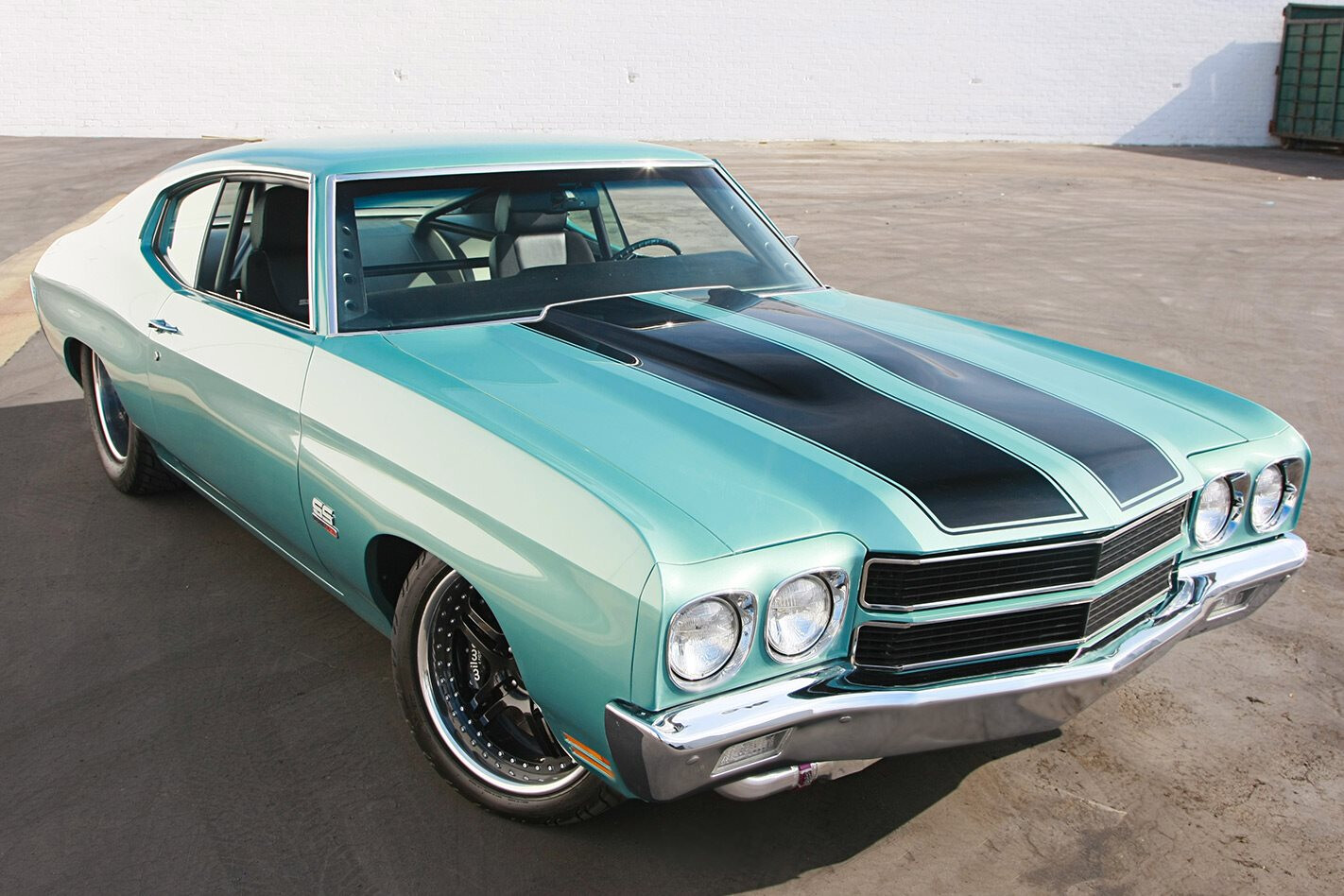
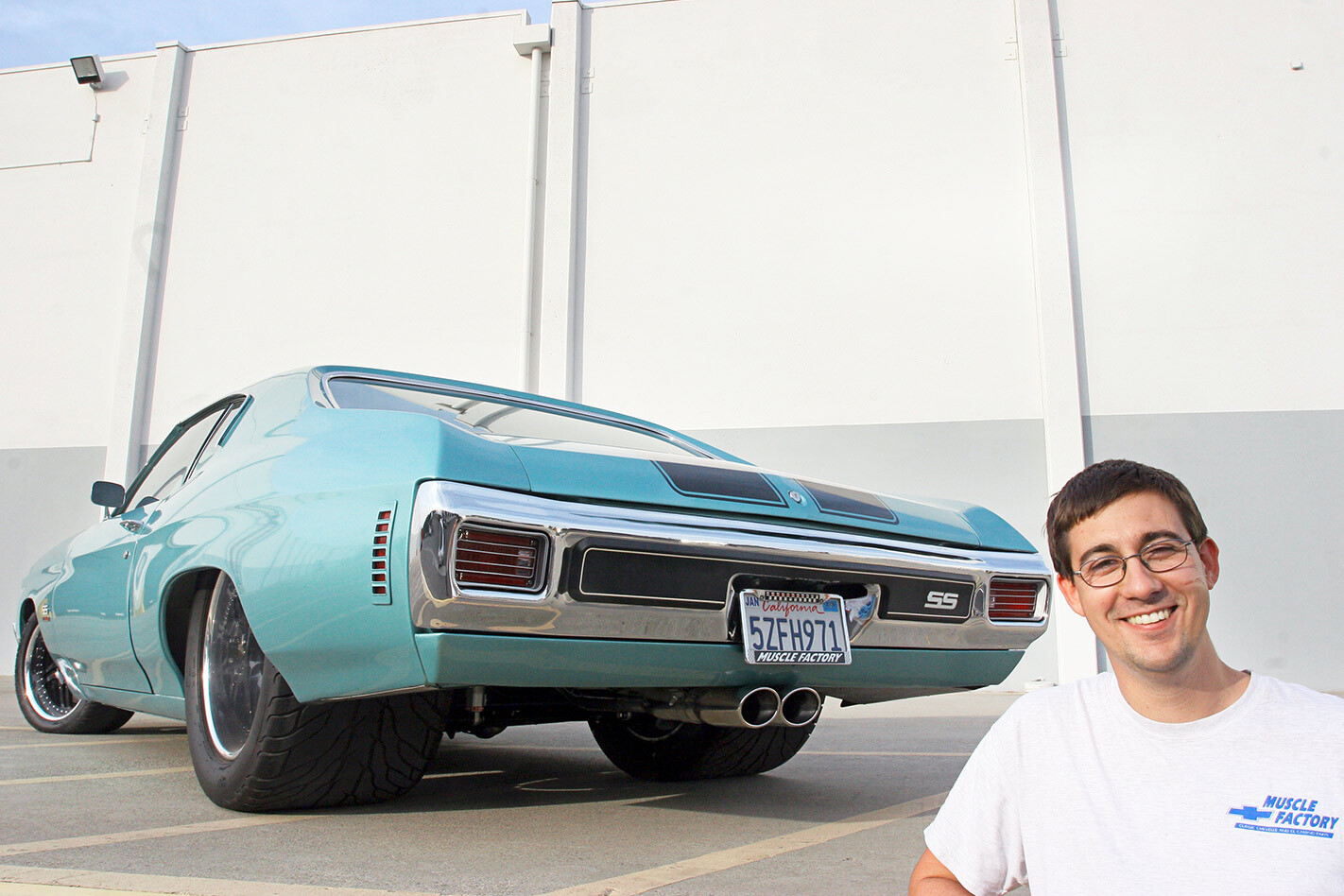
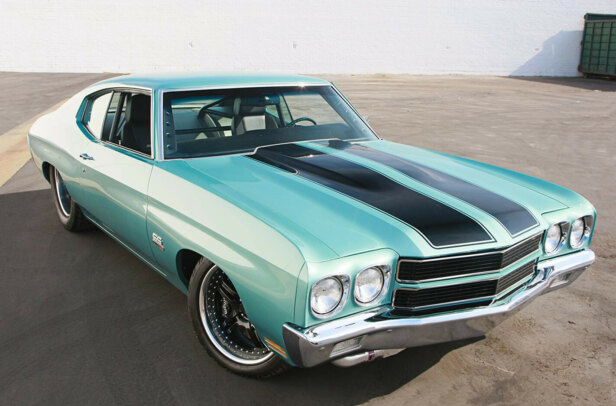
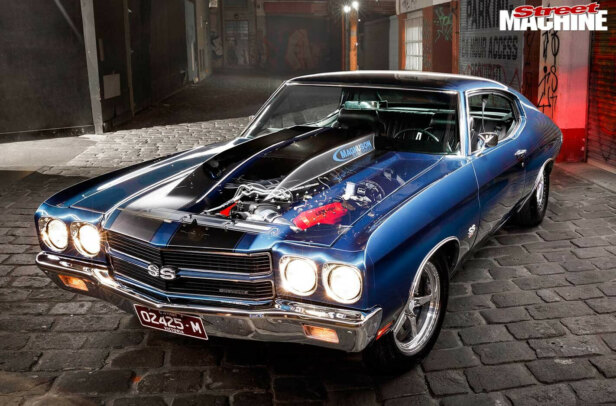
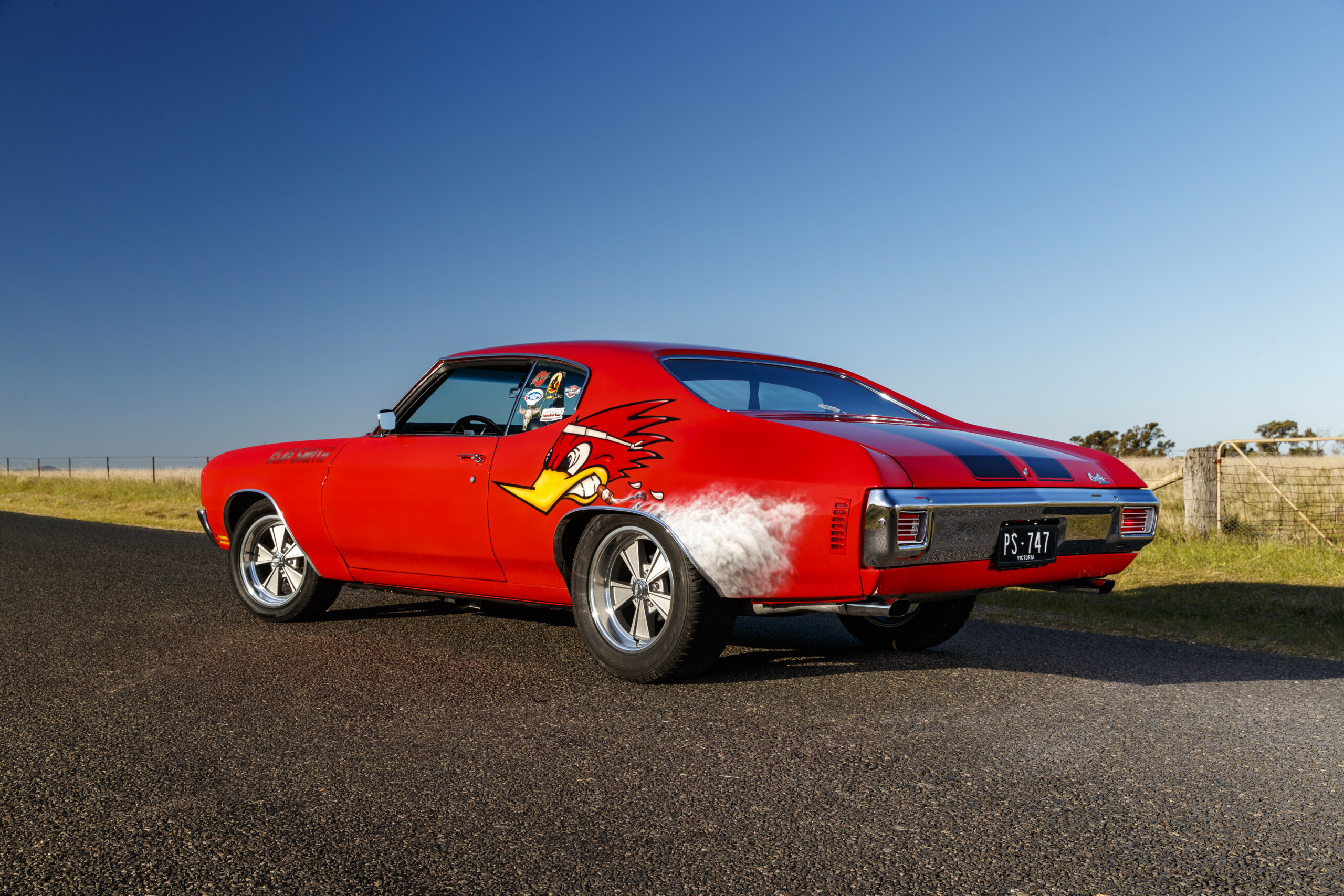
Comments